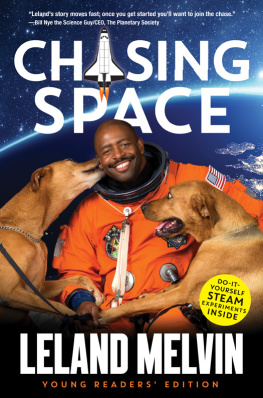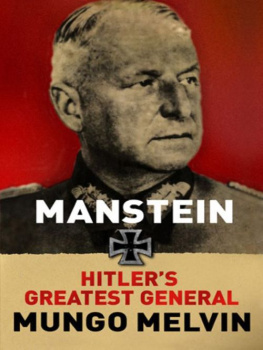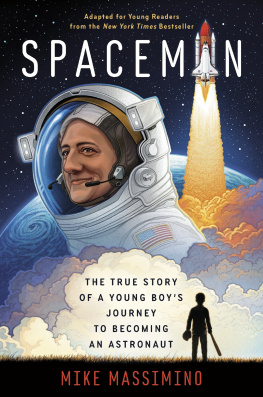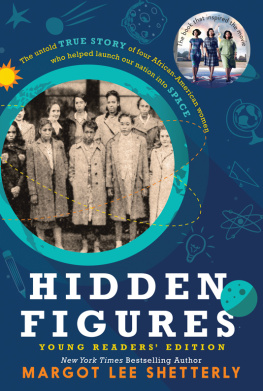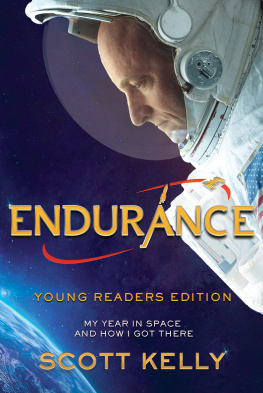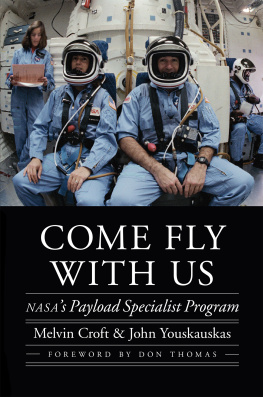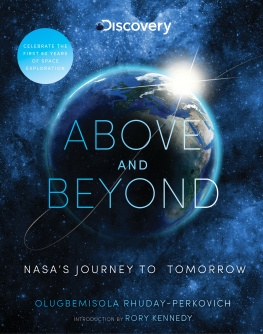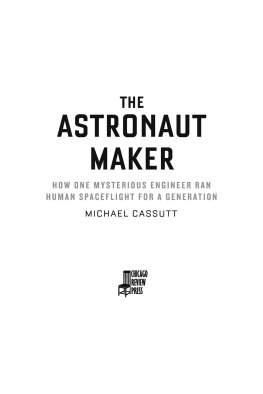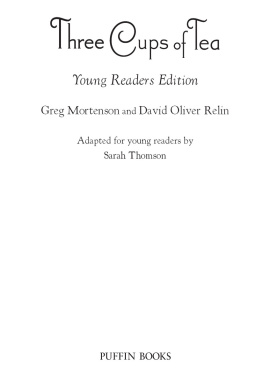Melvin - Chasing Space Young Readers Edition
Here you can read online Melvin - Chasing Space Young Readers Edition full text of the book (entire story) in english for free. Download pdf and epub, get meaning, cover and reviews about this ebook. City: United States, year: 2017, publisher: HarperCollins;Amistad, genre: Non-fiction. Description of the work, (preface) as well as reviews are available. Best literature library LitArk.com created for fans of good reading and offers a wide selection of genres:
Romance novel
Science fiction
Adventure
Detective
Science
History
Home and family
Prose
Art
Politics
Computer
Non-fiction
Religion
Business
Children
Humor
Choose a favorite category and find really read worthwhile books. Enjoy immersion in the world of imagination, feel the emotions of the characters or learn something new for yourself, make an fascinating discovery.
- Book:Chasing Space Young Readers Edition
- Author:
- Publisher:HarperCollins;Amistad
- Genre:
- Year:2017
- City:United States
- Rating:4 / 5
- Favourites:Add to favourites
- Your mark:
- 80
- 1
- 2
- 3
- 4
- 5
Chasing Space Young Readers Edition: summary, description and annotation
We offer to read an annotation, description, summary or preface (depends on what the author of the book "Chasing Space Young Readers Edition" wrote himself). If you haven't found the necessary information about the book — write in the comments, we will try to find it.
Melvin: author's other books
Who wrote Chasing Space Young Readers Edition? Find out the surname, the name of the author of the book and a list of all author's works by series.
Chasing Space Young Readers Edition — read online for free the complete book (whole text) full work
Below is the text of the book, divided by pages. System saving the place of the last page read, allows you to conveniently read the book "Chasing Space Young Readers Edition" online for free, without having to search again every time where you left off. Put a bookmark, and you can go to the page where you finished reading at any time.
Font size:
Interval:
Bookmark:
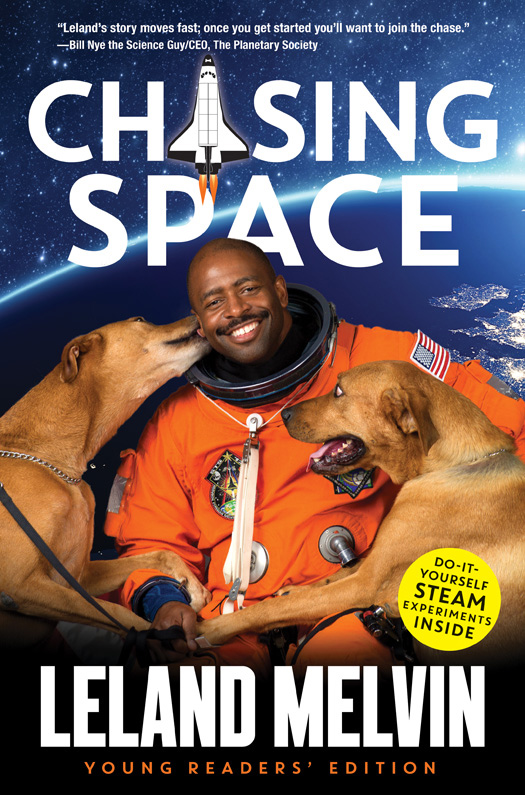
This book is dedicated to my family:
my father, who exemplified grit; my mother, who exudes her namesake, Grace; my sister, who shows me love;
and my niece, Second Chances.
And finally, my great-niece, who inspires my childlike wonder, infused with hope and optimism.
Thank you, Mom, Dad, Cat, Britt, and C.
Love, Leland
CONTENTS
T his was itApril 3, 2001. My first day of spacewalk training. Like all astronauts, I couldnt wait to leave Planet Earth and soar into space. But first I had to learn how to walk in space. Not easy, especially while youre traveling 17,500 miles an hour, 249 miles above Earth. Thats like learning to walk while speeding around the planet more than thirty times faster than your average jet travels and being on top of a Mount Everest thats forty-five times bigger than the actual Mount Everest.
Like I said, not easy.
But mastering the technical skills for spacewalking is the fastest way for an astronaut to get a NASA flight assignment. Just because youre an astronaut doesnt mean you ever get to go into space. To go into space, you need to get assigned to a flight. Its the last step in a journey that can take a lifetime. And not all astronauts walk in space. Some command or pilot the spacecraft. Others are mission specialists who do scientific experiments or work the shuttles robotic arm. But astronauts who are trained in spacewalking are always in demand. More than anything, I wanted a flight assignment and was willing to do whatever it would take to get one.
Astronauts do their spacewalk trainingalso known as extravehicular activity (EVA) trainingin a 40-foot-deep pool of water. A space shuttle and a replica of the International Space Station are submerged at the bottom of the pool, and the EVA suits we wear, combined with the water, make us feel like we are in the weightless environment of space. The white, puffy suits we wear underwater are almost identical to the ones astronauts wear when were out in the stratosphere. The only difference is that the underwater suits have extra material that provides more buoyancy to better simulate the weightless feeling of being in space.
When my turn came to train, I put on my equipment and began my descent into the water, ready to master the tasks in front of me as quickly as possible. I wanted to show NASA that I could do everything from attaching hardware to the outside of the space station to walking by pulling myself along with my hands instead of using my feet.
When astronauts prepare for a spacewalk, we spend eight hours practicing in the pool for every one hour well be working in space. The reason we spend so much time training is to make sure that we prepare for anything and everything that could go wrong.
On that fateful April day, I had reached a depth of about ten feet when I noticed that a little block of Styrofoam, called a Valsalva Pad, was missing. The pad is standard equipment in our EVA helmets. It is used to help a diver clear his ears and adapt to increasing air pressure while underwater. We need it because our ears cant always keep up with the changes in pressure that come when were descending into the pool. It can be hard to hear. Sometimes it can hurt a little, until we pop our ears by yawning, swallowing, or by using the pad. To clear your ears with the Valsava Pad, you press your nose against the pad to block your nostrils and then close your mouth and blow out your nose. But my suit didnt have a pad. For whatever reason, that small but very important piece was missing.
As soon as I noticed the missing pad, I used my headset to let test director Greg Sims know. He suggested I come out of the pool to have one installed, but I knew that any delay in my training exercises would lead to a delay in my being assigned a mission. I told Greg Id stick it out.
Okay, he said. Just dont hurt yourself.
Greg is a good friend and great test director. Hes dedicated his life to helping astronauts prepare for space travel. Hes also a huge football fan. He couldnt believe that I had once played for his favorite team, the Dallas Cowboys. Maybe thats why he agreed to let me stay in the pool. Either way, at the time we were both convinced that it wasnt going to be a problem.
And boy were we wrong.
Before long, my ears felt full. I tried to clear them by pressing my nose up against the helmet neck ring, but it was too far away.
Doctors later said that my high tolerance for pain and my background as a pro athlete probably kept me from realizing how serious the problem had become. I was used to playing through pain. Part of me always thought if it doesnt hurt, it doesnt work.
But by the time I was about twenty feet below the surface, I knew something was really wrong. I cant hear, I told Greg. Can you turn the volume up?
I strained to make out a response, but all I heard was static. I thought something was wrong with my headset or with the cable running from my suit to the pool deck. Maybe a kink in the cable had shut down the communication system. I assumed they were working to fix the problem, but under the water, it felt like they were ignoring me.
Turn up the volume, I shouted into the microphone.
Instead of doing that, they raised me slowly up and then lowered me down in the water again. They did that a few times, but I still couldnt hear Greg. Seconds later, more crackles and static came over the headset. There was a voice underneath the noise, but it wasnt clear. I couldnt make out the words.
I really cant hear you, I said.
Minutes later, I was being pulled to the pools surface.
Far below, my fellow trainee Danny Olivas was at the bottom of the pool, ready to prove his mastery of the EVA tasks. I knew he was probably wondering if my problem was going to slow him down.
Dr. Richard McCluskey, the NASA flight surgeon, was poolside when I came out of the water. I saw his mouth moving, but I couldnt hear anything he said. I couldnt understand why he didnt just speak up. I kept telling him to speak up. Everyone around me looked concerned. They were all moving their mouths, but I couldnt make out what they were saying. It was like watching a movie with the mute button on.
The doctor reached out and touched my right ear. I saw blood on his finger. It was running down my face. Until that moment, I still thought the problem had been with my headset. Suddenly, I knew it was something else. Even so, I didnt think there was a major problem. I trusted the flight surgeons. NASA was like a family to me. These were the best doctors in the world. This was a minor setback. Theyd fix whatever was wrong.
Standing by the side of the training pool, Dr. McCluskey looked into my ears and saw that my eardrums were pushed farther back inside my ears than they should have been. He thought the change in underwater pressure had caused it, so he gave me a nasal spray and then blew air into my nose to inflate the middle ear.
My ears were still blocked.
Then he decided to walk me around the corner to the hypobaric altitude chamber, which makes you feel like youre going up in an airplane. He thought another change in air pressure might help clear my ears.
The chamber was a steel tube able to simulate being at an altitude of 10,000 feet. The Empire State Building is 1,250 feet tallso being in the chamber felt like being on top of eight Empire State Buildings stacked one on top of another! At first I didnt feel any different, but when Dr. McCluskey blew air into my nose again, my ears cleared and I could hear a little better. I could hear people talking from about five feet away. But the minute they adjusted the settings so that it felt like I was back at sea level, my ears blocked up. I couldnt hear, again.
Font size:
Interval:
Bookmark:
Similar books «Chasing Space Young Readers Edition»
Look at similar books to Chasing Space Young Readers Edition. We have selected literature similar in name and meaning in the hope of providing readers with more options to find new, interesting, not yet read works.
Discussion, reviews of the book Chasing Space Young Readers Edition and just readers' own opinions. Leave your comments, write what you think about the work, its meaning or the main characters. Specify what exactly you liked and what you didn't like, and why you think so.

